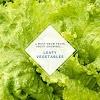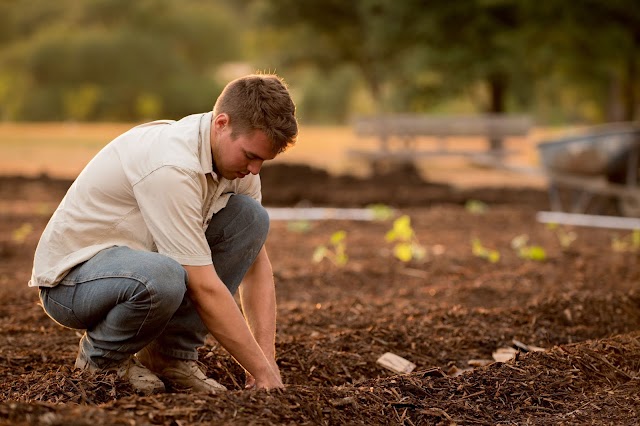Start by thinking about what you’d like to grow. Some factors to consider,
1) How much of the year is left?
If you are planning your garden during the winter, or as late in
the spring as May, you can still potentially grow anything you want. As you get later in the year,
however, more and more different crops are eliminated from the list of crops you can plant. Why is
this? It has to do with the “days to maturity” needed for different crops. Just as a person takes
about 18 years to reach physical maturity, each different crop needs at least a certain number of
days to grow from seed to the point where it is harvestable. Some plants like radishes and lettuce
can be harvested in as little as 30 days, but others like peppers and watermelons and Brussels
sprouts may need as many as 120 frost-free days to give you a crop. If there aren’t enough warm
days left in the year for a plant to produce what you want, planting that plant will be a waste of space
in your garden.
2) Geographic Location
All of the crops discussed in this manual can be grown in southern Wisconsin (and, more generally) the upper Midwest, but some of them are harder to grow than others
because of the relatively short growing season in this area. Tomatoes, peppers, eggplant, melons,
and squash are sensitive to cold (particularly when the plants are young) and must be protected
from it in special ways and/or planted within a narrow time window. Most common fruits, vegetables,
herbs, and flowers do best in full sun, so gardeners whose garden space is significantly shaded by
trees or buildings will have a limited set of crops to grow even if they live far to the south of Wisconsin.
3) Space
If your garden is small (say, less than 8 m or 25 ft on a side), there are certain crops you
may not want to grow, just because they take up too much space (and will thereby keep you from
growing much else). Unfortunately, this list includes popular favorites such as corn, potatoes, melons, squash, and pumpkins (and perhaps cucumbers, though they can be trained up wood, string, or
metal structures called trellises so that they take less space). These plants are fun to grow and are
still discussed in this manual, but if you choose to grow them you should do so with the knowledge
that they may get very, very big and will tend to shade out or literally overrun your other crops.
Some compact crops for small gardens are beans, beets, cabbage, carrots, greens (lettuce, spinach, and many other types), onions, radishes, and turnips.
4) Your own desires
Some gardeners only care about growing tomatoes, while others like to
have as much diversity as possible. Most gardeners fall somewhere in between. All of these strategies are fine, with the possible exception of growing only one crop year after year – this can lead to
a buildup of pest and disease problems (ideally, you’ll grow at least a few different crops and “rotate”
them around the garden so that no crop grows in the same place two years in a row). Before you
order seeds, buy transplants, or start digging in the garden, think about what you want. If there’s
something you really like (whether it’s tomatoes, salad greens, strawberries, flowers, or something
else), you’ll want to plan your garden around that. Some of your choices may be driven by what’s
available in local grocery stores or farmers’ markets and at what price. Decent potatoes and onions, for example, are cheap and widely available in stores and farmers’ markets, so growers with limited
space often skip these crops (though both are fun to grow, especially if you want to try varieties with
unusual colors, shapes, or flavors). Some gardeners really want to have asparagus, rhubarb, or
fruit. Keep in mind that many such perennial crops do not yield anything for at least two or three
years after planting. If you aren’t sure how long you’ll have your garden plot, don’t plant these crops.
In general, if you don’t have any particular desires, read the quick reference guide to vegetable
planting and the crop pages and try a bunch of different crops to find out what you like. Keep
notes on what does well in your soils and your climate.
5) Simplicity
It is easy to feel overwhelmed in the garden. For this reason alone, beginning gardeners may do well to choose as few as four crops (perhaps peas or a flower, tomatoes, cucumbers,
and lettuce), and try to grow these successfully before doing more the second year.
6) Difficulty of growing some crops
For various reasons, some plants are harder to grow than
others. Eggplant, for example, can be difficult to grow because (in some locations, at least) they
need to be protected from many different pests while also being kept warm. There are many plants
(garlic, tomatoes, and squash, for example) that will produce for you without enormous effort on your
part, but where a little extra care and attention can make for a much better crop. In general, if you
follow the planting and care suggestions in this manual, you should have success with at least some
crops each year. Even professional farmers lose crops to weeds, pests, disease, or simply a lack of
time needed to perform adequate care.
Once you have a list of crops you might want to grow, think about where and when you’ll grow those
crops. More factors to consider,
1) If you want to, you should be able to make all of the garden space “work” all the time. As
soon as a crop is done producing, you can plant another different crop right away, at least as long as
there is enough space for that crop and enough of the gardening season left for the crop to reach
maturity. Most of your garden can produce two or even three different crops in a season. For example, beans and tomatoes (which need warm weather to grow well) can follow early crops of lettuce,
spinach, radishes, or shallots (green onions) all of which are quick-growing and cold-tolerant. In
general, whenever an open space appears in your garden, fill it with something else (or mulch it). If
you don’t fill it, the weeds will. See garden plans for help figuring out how to do this.
2) Plan for the long-season crops first, and you’ll be able to fit in the shorter-season crops
around them. If you choose to grow them, perennial crops like asparagus, rhubarb, and raspberries take up sections of your garden for multiple entire years. Other crops like Brussels sprouts,
leeks, and parsnips tie up your garden space for just about the whole growing season (100 days or
more). Figure out where these crops will go, then worry about fitting in the medium-season crops
(plants like eggplant, tomatoes, broccoli that take 65-90 days to grow). The fast-growing crops (30-
60 days) can then be squeezed in around the others.
3) Consider using beds. Rectangular beds are handy because they allow you a lot of flexibility to
deal with plants of varying sizes. If you divide your whole garden into beds 1 m (40 in) across (and
however wide you choose), each bed can be used to grow either three equally spaced rows of small
crops (like salad greens), two equally spaced rows of medium-sized crops (like beans) or a single
central row of a large crop (like tomatoes). You can, of course, plant things in rows (or any which
way you choose), but rectangular beds with one, two, or three rows are simple and efficient. See
beds for diagrams and additional explanation.
4) Arrange your large plants so they won’t shade the others. Some plants (tomatoes, corn, and Jerusalem artichokes, for example) can shade out others. Put these plants where they have enough
room and won’t block the light (often in a bed at the edge of your plot). In general, the rows in your
garden should run north-south to allow light to get to all of the plants as the sun moves from east to
west across the sky.
5) Leave enough room between the rows to allow you to walk and remove weeds. In general,
the spaces required by the plants themselves will be fine for this, but a little bit too much space is
better than not enough space.
6) Make use of vertical space. In a small garden, you have a lot of vertical space, but not much
horizontal space. Stake or cage your tomatoes, trellis your peas and cucumbers (provide them with
structures made of wood, metal, and/or string to grow on), and you’ll have more room for other
crops.
7) Rotate crops so related plants don’t stay in the same place. Broccoli, cabbage, Brussels
sprouts, collard greens, kale, radishes, kohlrabi, rutabagas, turnips, and cauliflower are all very
closely related (they’re in the same plant family, known as “Brassicaceae,” or the mustard family).
As a result, they take the same nutrients out of the soil and are vulnerable to the same pests and
diseases. As much as you can, move these crops around your garden so that no two related crops
occupy the same space for two years in a row. There are other groupings of plants that should not
follow each other: Potatoes, tomatoes, peppers, and eggplant are in the family “Solanaceae” (sunloving family); Carrot, parsley, celery, parsley, dill, and parsnip are in the family “Apiaceae” (carrot
and parsley family); summer squash, winter squash, pumpkins, watermelon, cantaloupe, and cucumber are in the family “Cucurbitaceae” (gourd family); Chicory, endive, salsify, dandelion, lettuce,
Jerusalem artichoke, sunflowers, and globe artichoke are in the family “Asteraceae” (aster family);
Beets, chard and spinach are in the family “Chenopodiaceae” (goatsfoot family); and onion, garlic,
leek, and chives are in the family “Liliaceae” (lily family).
With the above factors in mind, create a garden plan for your garden. Your garden plan may or may
not be very detailed. Possible information to include,
1) The
location of each crop, including an approximate number of plants (look
at the “Quick Reference Guide for Vegetable Planting” for suggested
plant spacings).
2) Distances between rows (if you use the .
3) Which crops will occupy the same part of the garden at different times of the year.
4) Approximate planting dates, especially for plantings of lettuce, peas, radishes, and other quickgrowing vegetables of which you may put in multiple successive plantings.
Can you depart from your plan? Of course! Sometimes a crop never comes up at all due to bad
seed, or a crop dies before reaching maturity due to disease, insect damage, neglect, or some other
factor. You need to replace that crop with something (if you don’t, the weeds will fill that space), and
you need to choose something to replace it with. Other times, you may just decide to change your
plan for any old reason. That’s fine, but just make sure that whatever crop(s) you decide to plant will
have enough space and enough time to reach maturity before frost.
If all of this seems overwhelming, don’t worry – the most important thing to do is just start growing
something, even one crop! If you’re not using your space as efficiently as possible, or if some crops
don’t do as well as you would like, who (besides you, perhaps) cares? There’s always next year.








